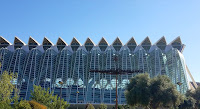Construction of The Church of the Holy Family was begun in 1883. It was designed by Gaudi and only a quarter of the construction was complete at his death in 1926. Construction of the church is funded solely on donations. Progress passed the midway point in 2010 with its completion estimated to be 2026.
An unforgettable visit to Montserrat ended our adventures in Barcelona. Montserrat is a mountaintop monastery that sits 4,000 feet above Barcelona. The road up to the site is strikingly beautiful and the views from the top are majestic. It's no wonder this area is Spain's first national park.
I'll end with photos of some of our favorite traveling companions.
 |
| Bob and Linda |
 |
| Jerry and Marilyn |
 |
| Dick and Janet |














































